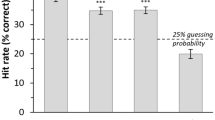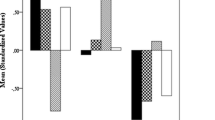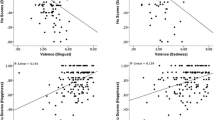Abstract
Several authors have recently presented evidence for perceptual and neural distinctions between genuine and acted expressions of emotion. Here, we describe how differences in authenticity affect the acoustic and perceptual properties of laughter. In an acoustic analysis, we contrasted spontaneous, authentic laughter with volitional, fake laughter, finding that spontaneous laughter was higher in pitch, longer in duration, and had different spectral characteristics from volitional laughter that was produced under full voluntary control. In a behavioral experiment, listeners perceived spontaneous and volitional laughter as distinct in arousal, valence, and authenticity. Multiple regression analyses further revealed that acoustic measures could significantly predict these affective and authenticity judgements, with the notable exception of authenticity ratings for spontaneous laughter. The combination of acoustic predictors differed according to the laughter type, where volitional laughter ratings were uniquely predicted by harmonics-to-noise ratio (HNR). To better understand the role of HNR in terms of the physiological effects on vocal tract configuration as a function of authenticity during laughter production, we ran an additional experiment in which phonetically trained listeners rated each laugh for breathiness, nasality, and mouth opening. Volitional laughter was found to be significantly more nasal than spontaneous laughter, and the item-wise physiological ratings also significantly predicted affective judgements obtained in the first experiment. Our findings suggest that as an alternative to traditional acoustic measures, ratings of phonatory and articulatory features can be useful descriptors of the acoustic qualities of nonverbal emotional vocalizations, and of their perceptual implications.

Similar content being viewed by others
Notes
To avoid multicollinearity being present in the dataset, only F0 mean, F0 variability, total duration, burst duration, percentage of unvoiced segments, harmonics-to-noise ratio, spectral center of gravity and intensity were used in the regression.
Only 4 trained listeners completed the mouth opening scale.
References
Bachorowski, J. A., & Owren, M. J. (2001). Not all laughs are alike: Voiced but not unvoiced laughter readily elicits positive affect. Psychological Science, 12(3), 252–257.
Bachorowski, J.-A., Smoski, M. J., & Owren, M. J. (2001). The acoustic features of human laughter. Journal of the Acoustic Society of America, 110, 1581–1597.
Banse, R., & Scherer, K. R. (1996). Acoustic profiles in vocal emotion expression. Journal of Personality and Social Psychology, 70(3), 614–636.
Boersma, P., & Weenink, D. (2010). Praat: Doing phonetics by computer [Computer program]. Version 5.1.13.
Bryant, G. A., & Aktipis, C. (2014). The animal nature of spontaneous human laughter. Evolution and Human Behavior, 35, 327–335.
Darwin, C. (1872). The expression of the emotions in man and animals. London: Murray.
de Krom, G. (1995). Some spectral correlates of pathological breathy and rough voice quality for different types of vowel fragments. Journal of Speech and Hearing Research, 38, 794–811.
Drolet, M., Schubotz, R. I., & Fischer, J. (2012). Authenticity affects the recognition of emotions in speech: Behavioral and fMRI evidence. Cognitive, Affective, and Behavioral Neuroscience, 12(1), 140–150.
Drolet, M., Schubotz, R. I., & Fischer, J. (2013). Explicit authenticity and stimulus features interact to modulate BOLD response induced by emotional speech. Cognitive, Affective, and Behavioral Neuroscience, 13(2), 318–329.
Drolet, M., Schubotz, R. I., & Fischer, J. (2014). Recognizing the authenticity of emotional expressions: F0 contour matters when you need to know. Frontiers in Human Neuroscience, 8, 144.
Edmonson, M. S. (1987). Notes on laughter. Anthropological Linguistics, 29(1), 23–34.
Eskenazi, L., Childers, D. G., & Hicks, D. M. (1990). Acoustic correlates of vocal quality. Journal of Speech and Hearing Research, 33, 298–306.
Ferrand, C. T. (2002). Harmonics-to-noise ratio: An index of vocal aging. Journal of Voice, 16(4), 480–487.
Gervais, M., & Wilson, D. S. (2005). The evolution and functions of laughter and humor: A synthetic approach. Quarterly Review of Biology, 80, 395–451.
Gobl, C., & Nί, C. A. (2003). The role of voice quality in communicating emotion, mood and attitude. Speech Communication, 40(1), 189–212.
Habermann, G. (1955). Physiologie und Phonetik des lauthaften Lachens. Leipzig: J. A. Barth.
Juslin, P., & Laukka, P. (2003). Communication of emotions in vocal expression and music performance: Different channels, same code? Psychological Bulletin, 129, 770–814.
Kohler, K. J. (2008). “Speech—Smile”, “Speech—Laugh”, “Laughter” and their sequencing in dialogic interaction. Phonetica, 65, 1–18.
Laukka, P., Juslin, P., & Bresin, R. (2005). A dimensional approach to vocal expression of emotion. Cognition and Emotion, 19, 633–653.
McGettigan, C., Walsh, E., Jessop, R., Agnew, Z. K., Sauter, D. A., Warren, J. E., & Scott, S. K. (2015). Individual differences in laughter perception reveal roles for mentalizing and sensorimotor systems in the evaluation of emotional authenticity. Cerebral Cortex, 25(1), 246–257.
McKeown, G., & Curran, W. (2015). The Relationship between laughter intensity and perceived humour. In Proceedings of the 4th interdisciplinary workshop on laughter and other non-verbal vocalisations in speech, Enschede, Netherlands (pp. 27–29).
McKeown, G., Sneddon, I., & Curran, W. (2015). Gender differences in the perceptions of genuine and simulated laughter and amused facial expressions. Emotion Review, 7(1), 30–38.
Narayanan, S., Nayak, K., Lee, S. B., & Byrd, D. (2004). An approach to real-time magnetic resonance imaging for speech production. Journal of the Acoustical Society of America, 115, 1771–1776.
Niedenthal, P. M., Mermillod, M., Maringer, M., & Hess, U. (2010). The Simulation of Smiles (SIMS) model: Embodied simulation and the meaning of facial expression. Behavioral and Brain Sciences, 33(06), 417–433.
Parsa, V., & Jamieson, D. G. (2001). Acoustic discrimination of pathological VoiceSustained vowels versus continuous speech. Journal of Speech, Language, and Hearing Research, 44(2), 327–339.
Provine, R. R. (1993). Laughter punctuates speech: Linguistic, social and gender contexts of laughter. Ethology, 95(4), 291–298.
Provine, R. R. (2001). Laughter: A scientific investigation. New York: Penguin.
Provine, R. R. (2012). Curious behavior: Yawning, laughing, hiccupping, and beyond. Cambridge: Harvard University Press.
Provine, R. R., & Yong, Y. L. (1991). Laughter: A stereotyped human vocalization. Ethology, 89(2), 115–124.
Ruch, W., & Ekman, P. (2001). The expressive pattern of laughter. In A. W. Kaszniak (Ed.), Emotion, qualia, and consciousness (pp. 426–443). Tokyo: Word Scientific.
Sauter, D., Eisner, F., Calder, A. J., & Scott, S. K. (2010). Perceptual cues in nonverbal vocal expressions of emotion. Quarterly Journal of Experimental Psychology, 63(11), 2251–2272.
Scherer, K. R. (1986). Vocal affect expression: A review and a model for future research. Psychological Bulletin, 99(2), 143.
Scherer, K. R., Johnstone, T., & Klasmeyer, G. (2003). Vocal expression of emotion. In R. J. Davidson, K. R. Scherer, H. H. Goldsmith (Eds.) Handbook of Affective Sciences (pp. 433–456) New York: Oxford.
Scott, S. (2013). Laughter-the ordinary and the extraordinary. Psychologist, 26(4), 264–268.
Scott, S. K., Lavan, N., Chen, S., & McGettigan, C. (2014). The social life of laughter. Trends in Cognitive Sciences, 18(12), 618–620.
Scott, S. K., Young, A. W., Calder, A. J., Hellawell, D. J., Aggleton, J. P., & Johnson, M. (1997). Impaired auditory recognition of fear and anger following bilateral amygdala lesions. Nature, 385, 254–257.
Van Hooff, J. A. R. A. M. (1972). A comparative approach to the phylogeny of laughter and smiling. In R. A. Hinde (Ed.), Non-verbal communication (pp. 209–237). Cambridge: Cambridge University Press.
Vettin, J., & Todt, D. (2004). Laughter in conversation: Features of occurrence and acoustic structure. Journal of Nonverbal Behavior, 28, 93–115.
Warhurst, S., Madill, C., McCabe, P., Heard, R., & Yiu, E. (2012). The vocal clarity of female speech-language pathology students: An exploratory study. Journal of Voice, 26(1), 63–68.
Wild, B., Rodden, F. A., Grodd, W., & Ruch, W. (2003). Neural correlates of laughter and humour. Brain, 126(10), 2121–2138.
Acknowledgments
We would like to thank Gary McKeown and one anonymous reviewer for thoughtful and constructive comments on earlier versions of the manuscript. Stimulus recording and data collection for Experiment 1 was supported by a Wellcome Trust Senior Research Fellowship (WT090961MA) awarded to Sophie Scott.
Author information
Authors and Affiliations
Corresponding author
Rights and permissions
About this article
Cite this article
Lavan, N., Scott, S.K. & McGettigan, C. Laugh Like You Mean It: Authenticity Modulates Acoustic, Physiological and Perceptual Properties of Laughter. J Nonverbal Behav 40, 133–149 (2016). https://doi.org/10.1007/s10919-015-0222-8
Published:
Issue Date:
DOI: https://doi.org/10.1007/s10919-015-0222-8




